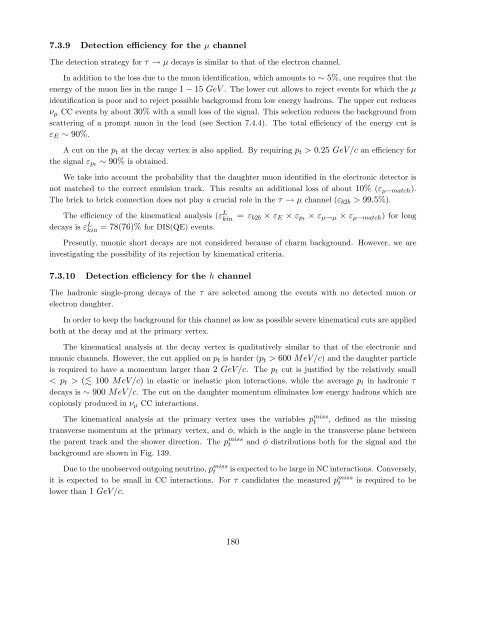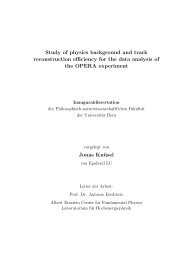Experiment Proposal - opera - Infn
Experiment Proposal - opera - Infn
Experiment Proposal - opera - Infn
Create successful ePaper yourself
Turn your PDF publications into a flip-book with our unique Google optimized e-Paper software.
7.3.9 Detection efficiency for the µ channel<br />
The detection strategy for τ → µ decays is similar to that of the electron channel.<br />
In addition to the loss due to the muon identification, which amounts to ∼ 5%, one requires that the<br />
energy of the muon lies in the range 1 − 15 GeV . The lower cut allows to reject events for which the µ<br />
identification is poor and to reject possible background from low energy hadrons. The upper cut reduces<br />
ν µ CC events by about 30% with a small loss of the signal. This selection reduces the background from<br />
scattering of a prompt muon in the lead (see Section 7.4.4). The total efficiency of the energy cut is<br />
ε E ∼ 90%.<br />
Acutonthep t at the decay vertex is also applied. By requiring p t > 0.25 GeV/c an efficiency for<br />
the signal ε pt ∼ 90% is obtained.<br />
We take into account the probability that the daughter muon identified in the electronic detector is<br />
not matched to the correct emulsion track. This results an additional loss of about 10% (ε µ−match ).<br />
The brick to brick connection does not play a crucial role in the τ → µ channel (ε b2b > 99.5%).<br />
The efficiency of the kinematical analysis (ε L kin = ε b2b × ε E × ε pt × ε µ→µ × ε µ−match )forlong<br />
decays is ε L kin<br />
= 78(76)% for DIS(QE) events.<br />
Presently, muonic short decays are not considered because of charm background. However, we are<br />
investigating the possibility of its rejection by kinematical criteria.<br />
7.3.10 Detection efficiency for the h channel<br />
The hadronic single-prong decays of the τ are selected among the events with no detected muon or<br />
electron daughter.<br />
In order to keep the background for this channel as low as possible severe kinematical cuts are applied<br />
both at the decay and at the primary vertex.<br />
The kinematical analysis at the decay vertex is qualitatively similar to that of the electronic and<br />
muonic channels. However, the cut applied on p t is harder (p t > 600 MeV/c) and the daughter particle<br />
is required to have a momentum larger than 2 GeV/c. The p t cut is justified by the relatively small<br />
( 100 MeV/c) in elastic or inelastic pion interactions, while the average p t in hadronic τ<br />
decays is ∼ 900 MeV/c. The cut on the daughter momentum eliminates low energy hadrons which are<br />
copiously produced in ν µ CC interactions.<br />
The kinematical analysis at the primary vertex uses the variables p miss<br />
t , defined as the missing<br />
transverse momentum at the primary vertex, and φ, which is the angle in the transverse plane between<br />
the parent track and the shower direction. The p miss<br />
t and φ distributions both for the signal and the<br />
background are shown in Fig. 139.<br />
Due to the unobserved outgoing neutrino, p miss<br />
t is expected to be large in NC interactions. Conversely,<br />
it is expected to be small in CC interactions. For τ candidates the measured p miss<br />
t is required to be<br />
lower than 1 GeV/c.<br />
180




